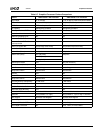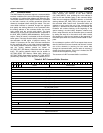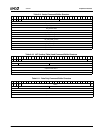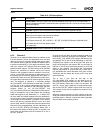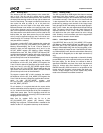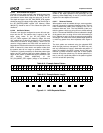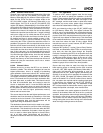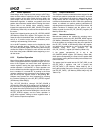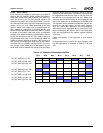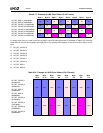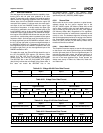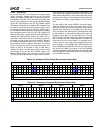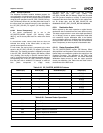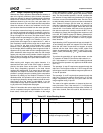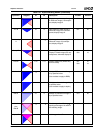
246 AMD Geode™ LX Processors Data Book
Graphics Processor
33234H
6.3.4 Vector Operation
Generating a vector requires a similar setup to a BLT. Reg-
isters must be written to specify the X and Y offsets of the
starting position of the vector within the frame buffer, the
vector length, and the three error terms required by the
Bresenham algorithm. In addition, any pattern colors and
pattern data should be loaded before initiating the vector.
Source data is not fetched when rendering vectors.
Instead, the contents of the GP_SRC_COLOR_FG register
(GP Memory Offset 10h) are used as the constant color for
the vector.
Vectors are initiated by writing to the GP_VECTOR_MODE
(GP Memory Offset 3Ch) register. This register also indi-
cates the need for destination data, and defines the major
axis (X or Y) and the major and minor directions (incre-
menting or decrementing) of the vector.
As in the BLT operation, vectors can be throttled by video
timing to prevent tearing. Setting the TH bit in the
GP_VECTOR_MODE register (GP Memory Offset 3Ch[4])
causes the Graphics Processor to wait until the next time
that video timing enters VBLANK before beginning to ren-
der the vector.
6.3.5 Pipelined Operation
Most of the graphics registers are pipelined. When the reg-
isters are programmed and the operation begins, the con-
tents of the registers are moved from slave registers to
master registers, leaving the slave registers available for
another operation. A second BLT or vector operation can
then be loaded into the slave registers while the first opera-
tion is rendered. If a second BLT is pending in the slave
registers, additional write operations to the graphics regis-
ters will corrupt the register values of the pending BLT.
Software must prevent this from happening by checking
the Primitive Pending bit in the GP_BLT_STATUS register
(GP Memory Offset 44h[2]).
The GP_PAT_COLOR_2 through GP_PAT_COLOR_5
(GP Memory Offset 20h-2Ch) registers are not pipelined. If
they are used in a new graphics operation, they should not
be written when the Primitive Busy bit (GP Memory Offset
44h[0]) is set and the Primitive Pending bit is not set in the
GP_BLT_STATUS register, and the active operation is
using these registers. Writing to these registers when a
BLT is active corrupts that operation.
6.3.6 Pattern Generation
The Graphics Processor contains hardware support for 8x8
monochrome patterns (expanded to two colors), and color
patterns. Color patterns can be 8x4 in 8-bpp mode, 8x2 in
16-bpp mode, and 8x1 in 32-bpp mode. Pattern alignment
is based on the destination X and Y LSBs of the pixel being
drawn, so software can perform pattern justifications by
adjusting these two parameters. For solid fill primitives, the
pattern hardware is disabled and the pattern color is
always sourced from the GP_PAT_COLOR_0 register (GP
Memory Offset 18h).
6.3.6.1 Monochrome Patterns
Monochrome patterns are enabled by selecting mono-
chrome pattern mode in the GP_RASTER_MODE register
(GP Memory Offset 38h). Pixels that correspond to a clear
bit in the pattern are rendered using the color specified in
the GP_PAT_COLOR_0 (GP Memory Offset 18h) register,
and pixels that correspond to a set bit in the pattern are
rendered using the color specified in the
GP_PAT_COLOR_1 register (GP Memory Offset 1Ch).
If the pattern transparency bit is set in the
GP_RASTER_MODE register (GP Memory Offset 38h),
those pixels corresponding to a clear bit in the pattern data
are not drawn, leaving the frame buffer pixels at these loca-
tions untouched.
The pattern itself is loaded into the GP_PAT_DATA_0 and
GP_PAT_DATA_1 registers, with row 0 loaded into
GP_PAT_DATA_0 (GP Memory Offset 30h[7:0] (bit 7
being the left-most pixel on the screen)), and row 7 loaded
into GP_PAT_DATA_1 (GP Memory Offset 34h[31:24], see
Table 6-16).



